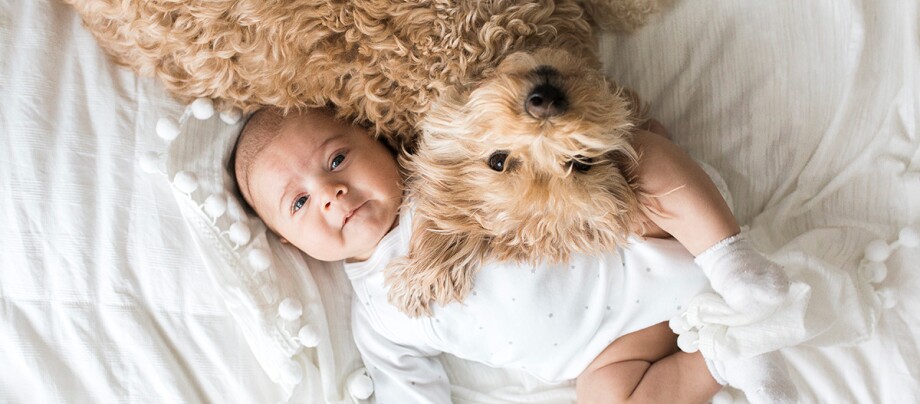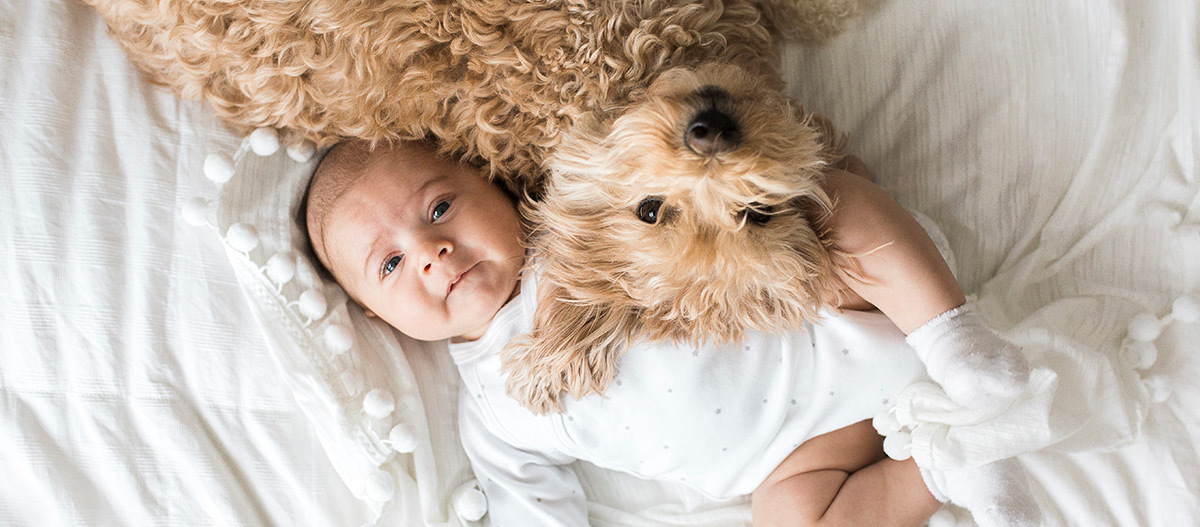Dog and Baby: Step-by-Step to Becoming the Perfect Dream Team
05.01.2024 - Reading time: 8 minutes

If you know that a baby is on the way, you can prepare your four-legged friend well with some important tips and useful tricks.
- Training during pregnancy: what changes when a baby arrives?
- Which dog suits babies/children?
- What can we train before the baby comes?
- Preparing the dog for a baby
- Plan everyday life with baby and dog in good time
- Baby and dog in the parents' bedroom?
- Get the dog and the baby used to each other
- Dog and baby: hygiene
- Your dog is not excited?
- Check list for getting a dog and baby together
Training during pregnancy: what changes when a baby arrives?
As pack animals, dogs are naturally positive about additions to the family. Starting training during pregnancy makes sense for two reasons:
A baby demands all of its parents attention, especially in the first few months. You will therefore have less time for your dog and therefore no capacity for additional training with him.
Your dog should not associate the changed circumstances – such as the fact that you have less time for him – with the arrival of the baby. It is therefore important to introduce the dog to the new situation gradually and, above all, at the right time.
Which dog suits babies/children?
You don’t have a dog yet, but would like to get a child-friendly companion? Then, the frequently asked question about the right breed is not so easy to answer, because all dogs are individually different. A certain stress resistance, sociability, low hunting instinct and good-natured, balanced nature naturally make socialising easier. That is why Labradors, golden retrievers, Bernese mountain dogs or cocker spaniels are often found in families, while Rottweilers or greyhounds are more rare. However, this does not mean that dogs of these breeds are not family-friendly: if the dog is socialised and trained properly and its temperament is suitable, then there is no reason for not choosing it.
Are you wanting to buy a puppy? Then make sure that the puppy has already been introduced to children in its first weeks of life.
Important: Never get a puppy during pregnancy! Soon you will no longer have time for the necessary training. You will do neither yourself nor the puppy any favour.
What can we train before the baby comes?
One of the basic things a dog must already be able to do, when the baby arrives, is to come reliably and go to his place on command. He should be retrievable in any situation – indoors and outdoors!
Also, don’t forget to train him regularly to let his toys or „found objects“ be taken away. Babies and small children in particular think nothing of grabbing such an object and the dog should put up with it without growling.
Practise in advance, if the dog is foreseeably not allowed to do certain things, e.g. lie on the sofa or enter the nursery. This way he does not associate these prohibitions with the newborn. In addition, you have enough time to train the dog to the new rules consistently.
Has the expectant mother been the dog’s main caregiver up to now? Then it is helpful, if the partner takes on more tasks as a matter of course. This reduces the stress for mum and dog when the baby arrives.
Preparing the dog for a baby

Get a sound CD that has baby cries and baby babble on it. Many dog owners underestimate the need for the dog to get used to the new sounds. Play the CD softly at first and then a little louder each day, until you reach the normal baby crying volume. Pay little attention to it and go about your normal life. It is important for your dog that it all becomes part of the routine, without extra reinforcement, negative or positive attention.
Your dog can also get used to new smells of e.g. nappies, powder or oil, if these things come home well before the birth – which they usually do anyway. The usefulness of used baby nappies as a „smell test“ is debatable.
To test in advance how your dog reacts to children, meet friends or relatives with babies and toddlers and keep a close eye on your four-legged friend.
If you like, go for a walk with the empty pram (even if it gets you strange looks from other passers-by) to get your dog used to the accessory and the new pace. During these walks, train your dog’s basic obedience, especially retrieval. This way he will quickly understand that he has to be very reliable, especially when walking with a baby. And don’t forget to time your walks a little later and even a little later. The same applies to feeding times. The more flexible your pet is in this respect, the less stress you will have later on.
Plan everyday life with baby and dog in good time
If you are not sure about everything you need to consider: let experienced parents and dog owners tell you about their experiences with dogs and babies and what your everyday life as a mother/father with a dog might look like in the future. Breastfeeding times, nappy-changing, cuddling times with the baby, changed wake-up times, walks with the pram – all of this can be predicted, at least to some extent. It becomes clear quickly that the dog will have to take a back seat in the future, and that is exactly what should become normal and even pleasant, for him.
Set up a particularly attractive retreat for your four-legged friend in the living room – a super fluffy blanket, a basket or a particularly comfortable cushion. This is where he can retreat to when the hustle and bustle gets too much for him or when you want him to take a break. Choose a corner that is closed on two sides, but from where the dog has a good view of his surroundings.
At first, lure him there with a treat, let him lie down (comfortably, not „down“) and reinforce this with a treat. At first he will want to get up more often and follow you. Then send him back. Do this as often and for as long as he stays calm, even if you walk around the room or leave it.
Remember to always follow through with your „Quiet“ command: Go up to the dog, praise him briefly and „release“ him with a „Come here“ or „Run“. Soon your dog will have understood the meaning of the exercise and will stay relaxed in this place. By the way, this place should be off-limits for your child right from the start, so that the four-legged friend also has a place, where he can feel safe and undisturbed.
Plan for critical situations like „the doorbell rings“ and how you will deal with them. Where does the dog go when you leave the baby? A lockable dog crate, a house leash or a door gate are good options.
Remember: never – absolutely never! – should you leave the dog and baby alone. Regardless of how good-natured he has been so far or how quickly you go and get something. Dogs are unpredictable and a sudden movement of the baby or a stressful situation can cause unexpected harm.
Baby and dog in the parents' bedroom?
It sounds enticing and cosy. However, you can’t watch what your dog does while you sleep. Therefore, during pregnancy, it is better to establish a dog sleeping area outside the parents‘ bedroom, if you plan to have your baby sleep with you.
Get the dog and the baby used to each other
When the dog and the baby meet for the first time, greet the dog as usual. Don’t make a big deal out of it, even if you are very excited. It is most helpful for your dog, if everything remains as normal as possible. He’ll get used to the baby’s presence and smell over time. Stick to your rules and be a reliable partner, that’s the best way to help your pet.
If you have prepared your dog for the new arrival, he will very quickly accept the baby as a new member of the family, and when the baby is a little older, the two of them will definitely become the best of friends.
Dog and baby: hygiene
Of course, your dog should not lick the newborn baby’s face or put baby things in its mouth. You must wash your hands after every contact with the dog, if it is the baby’s turn afterwards. Washing your hands before breastfeeding or feeding is also important.
At the same time, your home does not have to be clinically clean. Normal regular cleaning is enough. However, from the crawling age at the latest, you will voluntarily wipe more often to prevent your baby from finding anything too unsavoury on the floor. Dirty street shoes stay outside, muddy dog paws should be cleaned well before entering the house.
To protect the baby, also think about your dog’s health care: regular deworming, treatment against external parasites and vaccinations not only protect the dog, but also prevent the transmission of dangerous parasites to the baby.
Your dog is not excited?
Obviously, your pet needs some time to adjust to the new situation. However, please get professional help quickly, if you recognise signs of permanent stress, your dog’s character changes a lot or you notice the slightest signs of aggression towards the baby! A qualified dog trainer or a vet specialising in behavioural medicine can analyse the situation and improve it with adapted training sessions.
The sooner you initiate this, the better, because: The more recent the new behaviour is, the quicker and easier it will be for the dog to drop it.
Check list for getting a dog and baby together:
- Get a CD with baby sounds and play it several times a day.
- Take a teddy or a doll and play „baby“ with it. This way the dog gets used to not getting any attention while you are caring for the baby.
- Get the dog used to new or flexible walking and feeding times.
- Declare the baby’s room a no-go zone, long before the baby arrives.
- Train for walks with the pram, so that the dog gets used to the new pace and accessory.
- Set-up an especially cosy resting area for your dog.
- Be sure to deworm your dog, before the baby moves in.
- Bring the dog something from the hospital that smells like the baby.
- Never leave the dog alone with the baby. Unintentional roughness, for example, by spontaneously giving a paw, can also lead to serious injuries in young children.
- Don’t be afraid to seek professional help, if your dog fails to cope with the new situation.


